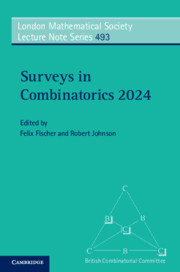Book contents
- Frontmatter
- Contents
- Preface
- Intersection Theory of Matroids: Variations on a Theme
- Erdős Covering Systems
- The Cluster Expansion in Combinatorics
- Sublinear Expanders and Their Applications
- Transversals in Latin Squares
- Finite Field Models in Arithmetic Combinatorics – Twenty Years On
- The Slice Rank Polynomial Method – A Survey a Few Years Later
- An Introduction to Transshipments Over Time
- Oriented Trees and Paths in Digraphs
- References
The Cluster Expansion in Combinatorics
Published online by Cambridge University Press: 23 May 2024
- Frontmatter
- Contents
- Preface
- Intersection Theory of Matroids: Variations on a Theme
- Erdős Covering Systems
- The Cluster Expansion in Combinatorics
- Sublinear Expanders and Their Applications
- Transversals in Latin Squares
- Finite Field Models in Arithmetic Combinatorics – Twenty Years On
- The Slice Rank Polynomial Method – A Survey a Few Years Later
- An Introduction to Transshipments Over Time
- Oriented Trees and Paths in Digraphs
- References
Summary
The cluster expansion is a classical tool from statistical physics used to study the phase diagram of interacting particle systems. Recently, the cluster expansion has seen a number of applications in combinatorics and the field of approximate counting/sampling. In this article, we give an introduction to the cluster expansion and survey some of these recent developments.
- Type
- Chapter
- Information
- Surveys in Combinatorics 2024 , pp. 55 - 88Publisher: Cambridge University PressPrint publication year: 2024



